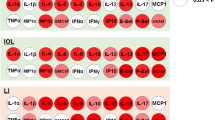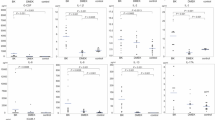Summary
Corneal cells are known to participate in the regulation of local inflammatory processes by secretion of cytokines. As the corneal endothelium may be exposed to endotoxin in organ culture and endotoxin is known to trigger inflammatory reactions, we investigated the effect of endotoxin from E. coli on organ cultured donor corneae with respect to autocrine and paracrine functions and the endothelial viability and density.
6 pairs of donor corneae were transferred to organ culture. Medium samples were taken prospectively from day 0 to day 20. On day 10 the medium was changed and one of each pair was incubated with 50 μg/ml of endotoxin while the other was immersed in standard organ culture medium. The samples were screened for IL-1, –2, –4, –5, –6, –8, –10, TNFα and GM-CSF by ELISA. In addition endothelial cell counts were performed at day 0, after 10 and after 20 days of organ culture, using the fixed frame technique.
All endotoxin-incubated organ culture media showed significantly increased IL-6 and –8 levels compared to the fellow cornea and to pre-exposure levels (P≤ 0.004). In the endotoxin-treated corneae a significantly higher endothelial cell loss occurred (P = 0.007) and signs of degeneration were observed. None of the other cytokines (IL-1α, IL-2, IL-4, IL-5, IL-10, GM-CSF and TNFα) were detected during either the first (1 to 10-day) or the second (11 to 20-day) phase of incubation.
A correlation seems to exist between an increase in IL-6 and –8 induced by endotoxin, and endothelial cell loss in organ culture.
Zusammenfassung
Korneale Zellen können bei der Regulierung lokaler inflammatorischer Prozesse durch Sekretion von Zytokinen mitwirken. Da das korneale Endothel in der Organkultur Endotoxinen ausgesetzt sein kann und Endotoxin ein potenter Auslöser entzündlicher Prozesse ist, untersuchten wir den Effekt von Endotoxin auf Spenderhornhäute in der Organkultur hinsichtlich ihrer autokrinen Funktion und der Endothelzellvitalität und Zelldichte.
6 Spenderhornhautpaare wurden in Standardmedium organkultiviert. Prospektiv wurden Mediumproben von Tag 0–20 entnommen. Nach 10 Tagen fand ein Mediumwechsel statt und eine der gepaarten Hornhäute wurde mit 50 μg/ml Endotoxin inkubiert, während die andere Hornhaut in Standardmedium kultiviert wurde. Die Mediumproben wurden mittels ELISA auf IL-1α, –2, –4, –5, –6, –8, –10, TNFα und GM-CSF untersucht. Die Endothelzelldichte wurde vor sowie 10 und 20 Tage nach Organkultur mit der fixed-frame Technik bestimmt.
Alle Endotoxin-inkubierten Hornhäute zeigten, verglichen zu den Kontroll-Hornhäuten, signifikant erhöhte IL-6 und IL-8 Werte (p≤ 0,004). Die Endotoxin-exponierten Hornhäute zeigten degenerative Veränderungen und einen signifikant höheren Endothelzellverlust im Vergleich zu den Kontrollen (p≤ 0,007). Keines der anderen Zytokine (IL-1α, IL-2, IL-4, IL-5, IL-10, GM-CSF and TNFα) wurde weder in der ersten (Tag 1–10), noch der zweiten Inkubationsphase (Tag 11–20) nachgewiesen.
Der Endotoxin-induzierte IL-6 und IL-8 Anstieg und der Endothelzellverlust in der Organkultur scheinen zu korrelieren.
Similar content being viewed by others
Author information
Authors and Affiliations
Rights and permissions
About this article
Cite this article
Ventura, A., Engelmann, K., Dahinden, C. et al. Influence of E. coli endotoxin on the auto-paracrine function and endothelial cell loss of cultured donor corneae. Ophthalmologe 95, 755–759 (1998). https://doi.org/10.1007/s003470050348
Published:
Issue Date:
DOI: https://doi.org/10.1007/s003470050348




